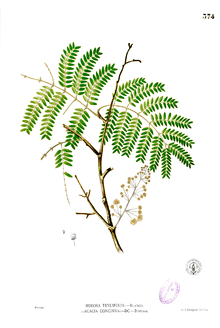Acacia concinna
Acacia concinna is a climbing shrub native to Asia, common in the warm plains of central and south India.[2] The tree is food for the larvae of the butterfly Pantoporia hordonia.[3] Alkaloids are found in the tree's fruit.[4] The species is invasive in New Caledonia.[5]
| Acacia concinna | |
|---|---|
 | |
| Scientific classification | |
| Kingdom: | Plantae |
| Clade: | Tracheophytes |
| Clade: | Angiosperms |
| Clade: | Eudicots |
| Clade: | Rosids |
| Order: | Fabales |
| Family: | Fabaceae |
| Clade: | Mimosoideae |
| Genus: | Acacia |
| Species: | A. concinna |
| Binomial name | |
| Acacia concinna | |
| Synonyms | |
| |
Archaeology
Pre Harappan level of Banawali (2750-2500 BC), Haryana have revealed traces of shikakai along with soap nuts and Amla (Indian Gooseberry), exhibiting ancient roots of South Asian hygiene.[6]
Uses
Shikakai
Acacia concinna has been used traditionally for hair care in the Indian Subcontinent since ancient times. It is one of the Ayurvedic medicinal plants. It is traditionally used as a shampoo [7] and it is also added in synthetic Ayurvedic shampoos. It is widely known as Shikakai. In order to prepare it the fruit pods, leaves and bark of the plant are dried, ground into a powder, then made into a paste. While this traditional shampoo does not produce the normal amount of lather that a sulfate-containing shampoo would, it is considered a good cleanser. It is mild, having a naturally low pH, and doesn't strip hair of natural oils. An infusion of the leaves has been used in anti-dandruff preparations.[8]
A. concinna extracts are used in natural shampoos or hair powders and the tree is now grown commercially in India and Far East Asia.[9] The plant parts used for the dry powder or the extract are the bark, leaves or pods. The bark contains high levels of saponins, which are foaming agents found in several other plant species used as shampoos or soaps. Saponin-containing plants have a long history of use as mild cleaning agents. Saponins from the plant's pods have been traditionally used as a detergent, and in Bengal for poisoning fish; they are documented to be potent marine toxins.
An infusion of the leaves of A. concinna has also been used for therapy of jaundice in the traditional Indian medicine.[10]
Chemical constituents
In commercial extracts, when the plant is hydrolyzed it yields lupeol, spinasterol, acacic acid, lactone, and the natural sugars glucose, arabinose and rhamnose. It also contains hexacosanol, spinasterone, oxalic acid, tartaric acid, citric acid, succinic acid, ascorbic acid, and the alkaloids calyctomine and nicotine.
Gallery
.jpg)
.jpg)
.jpg) Pods
Pods Seeds
Seeds
References
- "Acacia concinna". Germplasm Resources Information Network (GRIN). Agricultural Research Service (ARS), United States Department of Agriculture (USDA). Retrieved 2008-03-13.
- "Acacia concinna - ILDIS LegumeWeb". www.ildis.org. Retrieved 2008-03-13.
- "Pantoporia". www.funet.fi. Retrieved 2008-03-13.
- www.ingentaconnect.com Archived October 2, 2007, at the Wayback Machine
- Hequet, Vanessa (2009). Les Espèces Exotiques Envahissantes de Nouvelle Calédonie (PDF) (in French). p. 17.
- Bisht (1993). "Paleobotanical and pollen analytical investigations" (PDF). Indian Archaeology a review 1993-1994: 143–144.
- "Acacia concinna - Shikakai". www.flowersofindia.net. Retrieved 8 September 2018.
- "Shikakai for Hair: 16 Benefits and 11 Ways to Use it". beautystylr.com. 2017-04-29. Retrieved 8 September 2018.
- "Forestry :: Nursery Technologies". agritech.tnau.ac.in. Retrieved 8 September 2018.
- Tewari D, Mocan A, Parvanov ED, Sah AN, Nabavi SM, Huminiecki L, Ma ZF, Lee YY, Horbańczuk JO, Atanasov AG. Ethnopharmacological Approaches for Therapy of Jaundice: Part I. Front Pharmacol. 2017 Aug 15;8:518. doi: 10.3389/fphar.2017.00518.
External links
![]()
